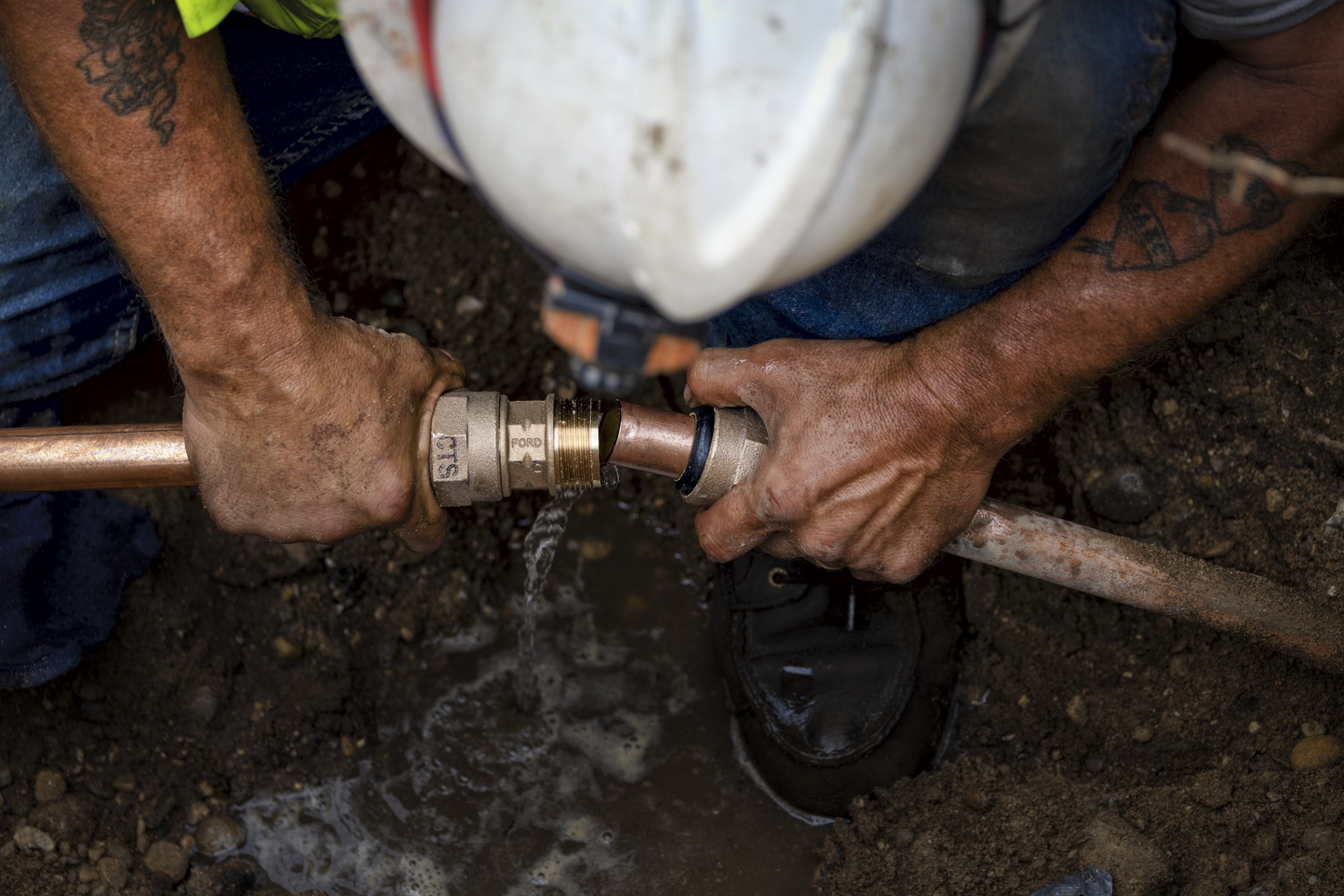Labor shortage could be a bottleneck as the country rebuilds.

Workers install new water lines in Traverse City, Michigan. Photo © J. Carl Ganter/Circle of Blue
By Brett Walton, Circle of Blue – July 20, 2023
Down the hole a new connection is muscled into place.
Bright-vested workers join pipe to pipe, one of many such couplings that will result in a new 8-inch water line for Traverse City.
The construction scene in northern Michigan is being repeated across the Great Lakes region and throughout the country as public works begin to reap the benefits of a federal spending splurge to enhance the nation’s water, energy, communications, and transportation systems while also boosting manufacturing capacity.
Local and corporate dollars will pay for some of these projects. But the infrastructure push is catalyzed by federal action. In the last two years Congress passed the Infrastructure Investment and Jobs Act, the Inflation Reduction Act, and the CHIPS Act. Combined, the three bills offer about $1.3 trillion in infrastructure loans, grants, subsidies, and tax credits over the next five to 10 years.
The outpouring of money signaled a core belief of President Joe Biden and the Democratic-controlled Congress that passed the bills: federal spending on the nation’s connective systems can strengthen economic prospects and improve public health. A gusher of public money, the thinking went, would be transformative: fast internet connections in rural areas, electric buses that do not belch heat-trapping gases that warm the planet, drinking water pipes that do not leach toxic lead and damage infant brains.
It is an all-hands approach to fashioning a 21st century infrastructure. But as federal funds begin to flow to states, tribes, and cities, a longstanding worry has resurfaced: where are all the hands to build these projects?
“The big question or the elephant in the room is: where are the workers going to come from?” said Joseph Kane, a fellow at the Brookings Institution who focuses on infrastructure.
The feared labor bottleneck is today more a specter than reality for water systems. Municipal groups in the Great Lakes region say they are not yet struggling to find contractors. “I have heard nothing from my members on this,” Kent Scarrett, executive director of the Ohio Municipal League, wrote in an email. Tim Neumann, executive director of the Michigan Rural Water Association, said the same.
Labor constraints are nonetheless a real threat in the coming years, Kane told Circle of Blue. Brookings reckons that nearly 17 million infrastructure workers – from electricians and carpenters to pipe fitters and plumbers – will retire, change jobs, or otherwise leave the workforce in the next decade. They will have to be replaced.
“It’s not like it’s all of a sudden a challenge,” Kane said. “It’s been evolving and mounting for years, and now it’s in the spotlight to the extent that there’s a big sack of money on the table.”
Despite the celebratory mood after the three infrastructure bills were passed, the true test will be implementation. Can state and federal agencies process funding applications on time? Will disadvantaged communities receive the benefits they were promised? Will requirements to promote raw materials sourced from the U.S. be a hindrance? Will there be enough workers?
Allen Gray of the Associated General Contractors of America (AGC), a trade group, said that hiring workers is “one of our most important issues” as construction companies face a wave of new building.
“The companies can ramp up and, we believe, have the wherewithal to handle it,” said Gray, who oversees AGC’s utility infrastructure division. “It’s whether they can get the workforce to handle what’s coming down the line.”
Ty Edmondson is CEO of T.A. Loving Company, a North Carolina-based construction company that builds water and wastewater projects. Edmondson believes that project size will be a factor. There’s capacity now for smaller jobs, like water main replacements. But a slew of new treatment plants all at once?
“There’s a limited amount of contractors that can do those really big jobs,” Edmondson said.
How big is the problem in the short term? Gray said that AGC is surveying its members right now to learn about existing and potential workforce shortages. Gray expects the survey results to be published later this year.
In the longer term, contractors are seeking to make their industry more attractive with pay increases and better benefits. Gray said AGC chapters are pitching their industry’s high-tech future, attending high school job fairs to entice potential recruits with heavy equipment and virtual reality machines that simulate job-site conditions.
“It’s a hard market to find labor,” Edmondson said. “We spend a big effort. We’ve got a lot of people that do nothing but try to find labor for us.”
Brett writes about agriculture, energy, infrastructure, and the politics and economics of water in the United States. He also writes the Federal Water Tap, Circle of Blue’s weekly digest of U.S. government water news. He is the winner of two Society of Environmental Journalists reporting awards, one of the top honors in American environmental journalism: first place for explanatory reporting for a series on septic system pollution in the United States(2016) and third place for beat reporting in a small market (2014). He received the Sierra Club’s Distinguished Service Award in 2018. Brett lives in Seattle, where he hikes the mountains and bakes pies. Contact Brett Walton





